胺化芳胺化反应综述
Buchwald–Hartwig 反应
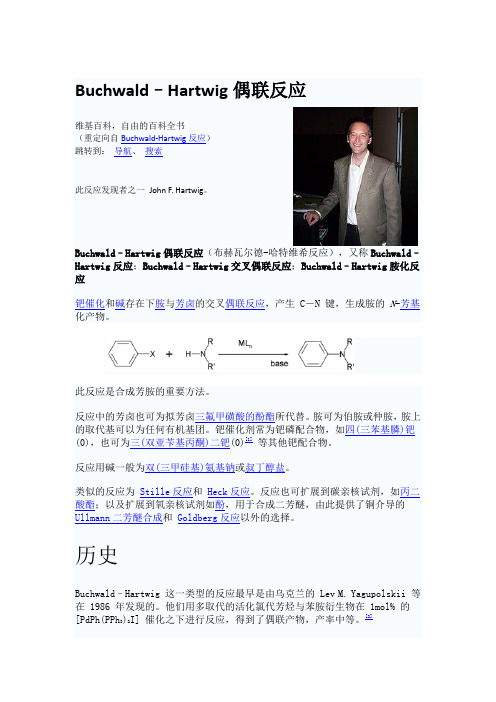
Buchwald–Hartwig偶联反应维基百科,自由的百科全书(重定向自Buchwald-Hartwig反应)跳转到:导航、搜索此反应发现者之一John F. Hartwig。
Buchwald–Hartwig偶联反应(布赫瓦尔德-哈特维希反应),又称Buchwald–Hartwig反应;Buchwald–Hartwig交叉偶联反应;Buchwald–Hartwig胺化反应钯催化和碱存在下胺与芳卤的交叉偶联反应,产生 C-N 键,生成胺的N-芳基化产物。
此反应是合成芳胺的重要方法。
反应中的芳卤也可为拟芳卤三氟甲磺酸的酚酯所代替。
胺可为伯胺或仲胺,胺上的取代基可以为任何有机基团。
钯催化剂常为钯磷配合物,如四(三苯基膦)钯(0),也可为三(双亚苄基丙酮)二钯(0)[1]等其他钯配合物。
反应用碱一般为双(三甲硅基)氨基钠或叔丁醇盐。
类似的反应为Stille反应和Heck反应。
反应也可扩展到碳亲核试剂,如丙二酸酯;以及扩展到氧亲核试剂如酚,用于合成二芳醚,由此提供了铜介导的Ullmann二芳醚合成和Goldberg反应以外的选择。
历史Buchwald–Hartwig 这一类型的反应最早是由乌克兰的 Lev M. Yagupolskii 等在 1986 年发现的。
他们用多取代的活化氯代芳烃与苯胺衍生物在 1mol% 的[PdPh(PPh3)2I] 催化之下进行反应,得到了偶联产物,产率中等。
[2]此后美国的 Buchwald 和 Hartwig 两个团队又分别在 1994 年重新发现这个反应。
耶鲁大学的 Hartwig 等用的是对溴甲苯与三丁基锡基胺之间的偶联。
[3]麻省理工学院的 Buchwald 等用的则是间溴苯甲醚与另一三丁基锡胺之间的偶联,见下。
[4]后来又发展了第二代的 Buchwald–Hartwig 反应,即用游离胺和强碱,代替最早使用的氨基锡烷。
[5]反应机理反应的催化循环如下。
首先 Pd II催化剂 (1)被还原为活性的 Pd0物种 (2),(2) 脱去一个配体形成(3),进入催化循环。
第十一章氨基化及芳胺基化

NH2
200~230℃, 7MPa 30%NH3. 0.1g离 子 Cu+
+ NH4Cl NH2
170~190℃, 3~3.5 MPa
+ NH4Cl NO2
NH2
115~120℃,常 压 30%NH3
NO2 NO2
+ NH4Cl
• 上述氨解反应的活泼顺序为:
Cl NO2 Cl Cl NO2 O2N NO2 NO2
1
• 3. 氨基置换硝基
• 反应按加成—消除反应历程进行。
NO2 O2N NO2 + NH2 NO2 N H NO2
• 硝基苯、硝基甲苯等未被活化的硝基不能作为离 去基团发生亲核取代反应。
1
• 4.氨基置换磺酸基
• 磺酸基的氨解也属于亲核取代反应。磺酸基被氨 基取代只限于蒽醌系列,蒽醌环上的磺酸基由于 受到羟基的活化作用,容易被氨基置换。其反应 历程如下:
• 1.氨基置换卤原子
• 按照卤素衍生物的活泼性的差异,可将氨基置换 卤原子的反应分为非催化氨解和催化氨解两类。
– (1)非催化氨解
• 其反应历程属于亲核置换反应。 • 对于活泼的卤素衍生物,如芳环上含有硝基的卤 素衍生物,通常以氨水为氨解剂,可使卤素被氨 基置换。例如,邻或对硝基氯苯与氨水溶液加热 时,氯被氨基置换反应按下式进行:
2
• 3. 反应温度
• 升高温度可以增加有机物在氨水中的溶解度和加 快反应速度,对缩短反应时间有利。但是温度过 高,会增加副反应,甚至出现焦化现象,同时压 力也将升高。
2
• 4. 搅拌
• 对于间歇设备都要求安装有效的搅拌装置,连续 管式反应器则要求控制流速使反应物料呈湍流状 态。
buchwald-hartwig 芳胺化反应

buchwald-hartwig 芳胺化反应
Buchwald-Hartwig芳胺化反应是一种官能团转移反应,通常用于合成芳香胺化合物。
在该反应中,苯胺与卤代芳烃在存在钯催化剂的情况下结合,生成相应的芳香胺。
反应机理包括以下步骤:
1. 钯催化剂与配体结合形成活性的钯催化剂。
2. 芳烃中的卤素离子发生还原消除,生成亲电芳香基。
3. 亲电芳香基与苯胺发生配位形成中间体。
4. 中间体中的钯催化剂被还原,同时胺离子发生消除还原,生成芳香胺产物。
Buchwald-Hartwig芳胺化反应的优点包括高选择性、宽广的反应底物适应性、高收率和易于实施。
该反应在有机合成中被广泛应用,并被认为是一种绿色合成方法。
另外,该反应还可以用于合成其他含氮杂环化合物,并且可以进行多步反应,扩展其反应适用范围。
胺化 (2)
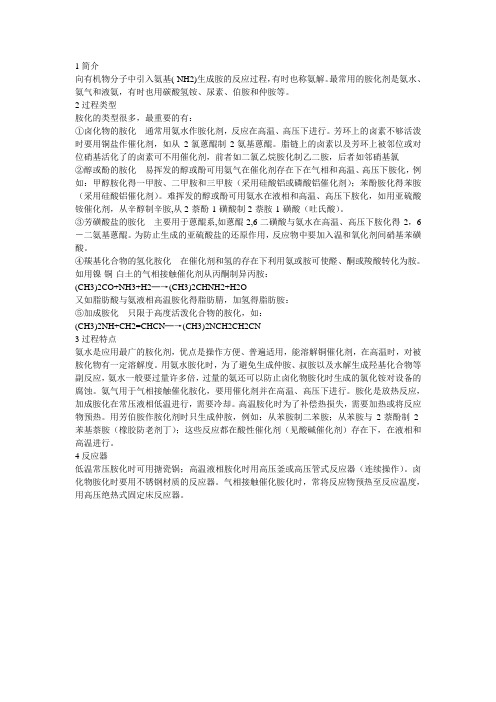
1简介向有机物分子中引入氨基(-NH2)生成胺的反应过程,有时也称氨解。
最常用的胺化剂是氨水、氨气和液氨,有时也用碳酸氢铵、尿素、伯胺和仲胺等。
2过程类型胺化的类型很多,最重要的有:①卤化物的胺化通常用氨水作胺化剂,反应在高温、高压下进行。
芳环上的卤素不够活泼时要用铜盐作催化剂,如从2-氯蒽醌制2-氨基蒽醌。
脂链上的卤素以及芳环上被邻位或对位硝基活化了的卤素可不用催化剂,前者如二氯乙烷胺化制乙二胺,后者如邻硝基氯②醇或酚的胺化易挥发的醇或酚可用氨气在催化剂存在下在气相和高温、高压下胺化,例如:甲醇胺化得一甲胺、二甲胺和三甲胺(采用硅酸铝或磷酸铝催化剂);苯酚胺化得苯胺(采用硅酸铝催化剂)。
难挥发的醇或酚可用氨水在液相和高温、高压下胺化,如用亚硫酸铵催化剂,从辛醇制辛胺,从2-萘酚-1-磺酸制2-萘胺-1-磺酸(吐氏酸)。
③芳磺酸盐的胺化主要用于蒽醌系,如蒽醌-2,6-二磺酸与氨水在高温、高压下胺化得2,6-二氨基蒽醌。
为防止生成的亚硫酸盐的还原作用,反应物中要加入温和氧化剂间硝基苯磺酸。
④羰基化合物的氢化胺化在催化剂和氢的存在下利用氨或胺可使醛、酮或羧酸转化为胺。
如用镍-铜-白土的气相接触催化剂从丙酮制异丙胺:(CH3)2CO+NH3+H2─→(CH3)2CHNH2+H2O又如脂肪酸与氨液相高温胺化得脂肪腈,加氢得脂肪胺:⑤加成胺化只限于高度活泼化合物的胺化,如:(CH3)2NH+CH2=CHCN─→(CH3)2NCH2CH2CN3过程特点氨水是应用最广的胺化剂,优点是操作方便、普遍适用,能溶解铜催化剂,在高温时,对被胺化物有一定溶解度。
用氨水胺化时,为了避免生成仲胺、叔胺以及水解生成羟基化合物等副反应,氨水一般要过量许多倍,过量的氨还可以防止卤化物胺化时生成的氯化铵对设备的腐蚀。
氨气用于气相接触催化胺化,要用催化剂并在高温、高压下进行。
胺化是放热反应,加成胺化在常压液相低温进行,需要冷却。
高温胺化时为了补偿热损失,需要加热或将反应物预热。
第九章 氨解和胺化
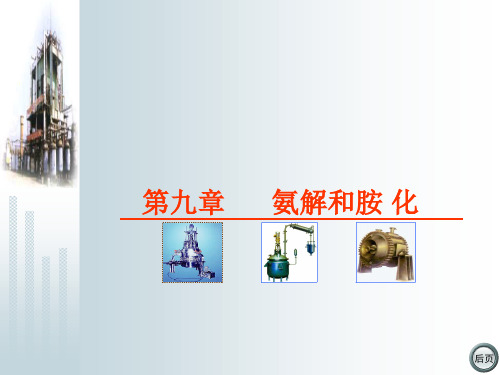
3 HO3S
24%NH3,氨比1:17 180~184℃,4MPa,24h
O O
3 H2N
SO3NH4 + 12NH3 + 2
NO2
+2H2O SO3Na
O
NH2 +2
NH2
+ 6 (NH4)2SO4
O
SO3Na
首页 前页 后页
精细有机单元反应
第九章 胺 化
第六节 芳环上氢的直接胺化
首页 前页 后页
精细有机单元反应
第九章 胺 化
二、酚羟基的氨解
合成苯系、萘系和蒽醌系芳胺衍生物
1、苯系酚类的氨解:主要用于苯酚的氨解制苯胺、 间甲酚的氨解制间甲苯胺。 2、萘酚衍生物的氨解:主要用于由β-萘酚及其衍生 物制备β-萘胺及其衍生物。它们的氨解必须采用 Bucherer反应。
某些萘酚与胺在亚硫酸盐存在下,生成萘胺的可 逆反应称布赫勒反应(Bucherer)。
②甘氨酸
第九章 氨解和胺 化
ClCH2COOH
NH4HCO3 NH4OH
NH2CH2COOH
生产流程:
首页 前页 后页
精细有机单元反应
第九章 胺 化
第二节 醇或酚羟基的氨解
一、醇羟基的氨解-合成低碳脂肪胺
1. 反应原理 醇类用氨的氨解反应可用下式表示:
NH3 +ROH
H2O
+ROH
RNH2 H2O
R2NH
+ROH H2O
R3N
首页 前页 后页
精细有机单元反应
2. 醇羟基的氨解方法
第九章 胺 化
(1)气固相接触催化氨解法是在脱水催化剂的存 在下使氨与醇发生反应。
芳胺化反应 经典化学合成反应标准操作

经典化学合成反应标准操作芳胺化反应目录一.前言 (1)二.影响Buchwald 反应的因素及Buchwald 反应的应用 (2)2.1 卤素对反应的影响............................................................................................................2.2 取代基团电子性对反应的影响.......................................................................................2.3 配体对反应的影响............................................................................................................2.4 胺与苯基三氟甲磺酸酯的反应(Triflate) .................................................................2.5 对伯胺及仲胺的选择性....................................................................................................2.6 对手性的影响 ....................................................................................................................2.7 与吡咯及吲哚的反应........................................................................................................2.8 关环反应.............................................................................................................................2.9 卤代苯转化为苯胺反应.................................................................................................... 三.反应操作示例..............................................................................................3.1 典型操作一 ........................................................................................................................3.2 典型操作二 ........................................................................................................................四、参考文献 .....................................................................................................概 述取代的芳胺、酰基芳胺及芳醚类化合物在药物化学中有着重要的作用, 长期以来一直没有一个较为通用的、温和的方法制备他们。
芳胺化反应-060114

经典化学合成反应标准操作芳胺化反应目录一.前言 (2)二.影响Buchwald 反应的因素及Buchwald 反应的应用 (3)2.1 卤素对反应的影响........................................................................................................2.2 取代基团电子性对反应的影响....................................................................................2.3 配体对反应的影响........................................................................................................2.4 胺与苯基三氟甲磺酸酯的反应(Triflate)...............................................................2.5 对伯胺及仲胺的选择性................................................................................................2.6 对手性的影响................................................................................................................2.7 与吡咯及吲哚的反应....................................................................................................2.8 关环反应........................................................................................................................2.9 卤代苯转化为苯胺反应................................................................................................ 三.反应操作示例.................................................................................................3.1 典型操作一....................................................................................................................3.2 典型操作二....................................................................................................................四、参考文献.........................................................................................................概 述取代的芳胺、酰基芳胺及芳醚类化合物在药物化学中有着重要的作用, 长期以来一直没有一个较为通用的、温和的方法制备他们。
还原胺化相关机理与反应

还原胺化(reductive Amination)1.定义:胺和羰基化合物缩合得到亚胺,然后通过还原剂(常用的有NaCNBH3,NaBH(OAc)3等)还原生成相应的胺的反应。
2.反应机理:3.主要特点:Borch还原或者还原烷基;能够有效的将醛或者酮转化成胺;席夫碱来源于羰基和氨基,然后由氢供体还原成胺;对于迟钝反应,如含弱亲电羰基、亲核胺、空间拥挤的反应中心,通常需要添加分子筛或路易斯酸;对于反应性好的胺,容易形成席夫碱,直接还原胺化提高了效率;对于低反应性的胺,在一般条件下很难形成席夫碱。
4.优势:操作简单,方便;能形成伯胺、仲胺、叔胺。
5.经典反应:1.催化氢化;2.金属氢化物;3.甲酸-Leuckart-Wallach 反应;4.其他还原剂如硼烷、锡烷以及不对称催化反应、金属络合物也被用于还原胺化,极大的促进了还原胺化反应的高选择性及效率。
具体反应类型介绍:催化氢化:1.通常用Pd/C、Raney-Ni和Pt/C催化氢化;2.如果反应底物含不饱和基团如C=C、CN、NO2则受限;3.反应操作简单,清洁、产率高硼氢化钠还原:硼氢化钠容易还原亚胺,也能够还原醛或者酮化合物,在直接还原亚胺时,如果有此类官能团应该保护起来,防止在还原亚胺时被还原;常用溶剂醇类和四氢呋喃。
硼氢化钠与酸性添加剂和脱水剂共同使用:提高中间体亚胺的活性;体系TFA/DCM、TFA/THF、H2SO4/THF;适合低活性胺,如4-硝基苯胺;可以用分子筛、硫酸钠、硫酸镁、氯化钙做脱水剂。
硼氢化钠与钛(IV)添加剂共同使用:TiCl4或Ti(O-Pr-i)4;辅助亚胺;TiCl4在惰性溶剂中使用如苯、THF、DCM;Ti(O-Pr-i)4可以溶于乙醇、异丙醇、甲苯;这些条件对低活性胺有用硼氢化钠与其他添加剂:氯化锌溶于DCM、THF中使用;三甲基氯硅烷氰基硼氢化钠NaB(CN)H3:有醛或酮存在下,弱酸性pH5-7条件下,选择性还原碳氮双键;氰基在水或醇中有一定的水解,常采用甲醇或乙醇作溶剂;亚胺还原的最佳pH5-7,因此通过添加盐酸甲醇溶液调节酸度;分子筛能够吸水从而促进亚胺的生成,也可以采用硫酸钠或者硫酸镁脱水。
芳胺化反应综述

报告人:张 俊 祥
Scheme
NH2
R'
+R +R
Y
Met.Cat., Base Solvent R
N
R'
R1 N
R2
Y
Met.Cat., Base Solvent
R1 N
R2
R
二芳胺化合物
Diarylamines were prepared by the condensation of an aniline with an arenesulfonic acid (8.90 mol) (1.56 mol)
J. Chem. Soc., Perkin Trans. 1, 2000, 2695–2701
三芳胺化合物
Base: KOH
Ullmann condensation of diarylamines with iodobenzenes has been investigated under homogeneous and heterogeneous catalytic conditions with cuprous and curpic salts, as well as powdered copper metal. Copper catalyzed condensation of diarylamines with iodoaromatics is relatively insensitive to substituent (for substituted iodobenzenes p = -0.25; for substituted diphenylamines p = 1.09) but quite sensitive to halogen ( k I / k B , > 200). This hypothesis rationalizes many of the perplexing results which typify the literature associated with copper catalyzed nucleophilic aromatic substitution.
第六章氨基化反应ppt课件
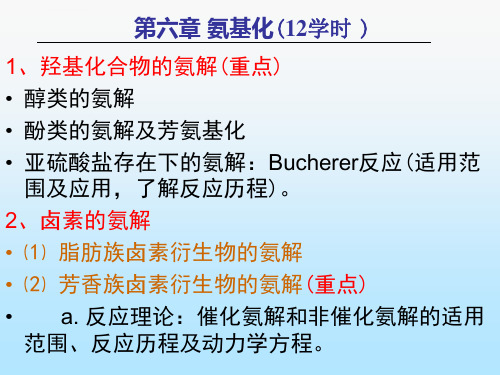
6.2 羟基化合物的氨解
• 气相氨解法:在催化剂(硅酸铝)存在下, 气态酚类与NH3进行g-s相催化反应。
• 液相氨解法:酚类与氨水在AlCl3、NH4Cl 等催化剂存在下,高温高压下制取胺类。
• 萘系 Bucherer 反应
认识到了贫困户贫困的根本原因,才 能开始 对症下 药,然 后药到 病除。 近年来 国家对 扶贫工 作高度 重视, 已经展 开了“ 精准扶 贫”项 目
6.2 羟基化合物的氨解
• 醇氨解的工业方法 气-固相接触催化脱水氨解
气-固相临氢接触催化胺化氢化 液相氨解法
比较:催化剂 反应温度 压力 适用范围
认识到了贫困户贫困的根本原因,才 能开始 对症下 药,然 后药到 病除。 近年来 国家对 扶贫工 作高度 重视, 已经展 开了“ 精准扶 贫”项 目
6.2 羟基化合物的氨解
6.2.2 芳环上羟基的氨解
•
包括苯系、萘系和蒽醌系羟基化合物
的氨解,反应历程和操作方法各不相同。
酚类 氨解法
气相氨解法 液相氨解法 Bucherer反应
认识到了贫困户贫困的根本原因,才 能开始 对症下 药,然 后药到 病除。 近年来 国家对 扶贫工 作高度 重视, 已经展 开了“ 精准扶 贫”项 目
表9-2。
• 优点 ?
• 缺点 ?
认识到了贫困户贫困的根本原因,才 能开始 对症下 药,然 后药到 病除。 近年来 国家对 扶贫工 作高度 重视, 已经展 开了“ 精准扶 贫”项 目
6.2 羟基化合物的氨解
Байду номын сангаас
某些胺类,若通过硝基还原或其他方 法制备并不经济,而相应的羟基化合物供 应充分时,则羟基化合物的氨解过程就具 有很大意义。
过渡金属催化卤代芳烃胺化反应的研究进展
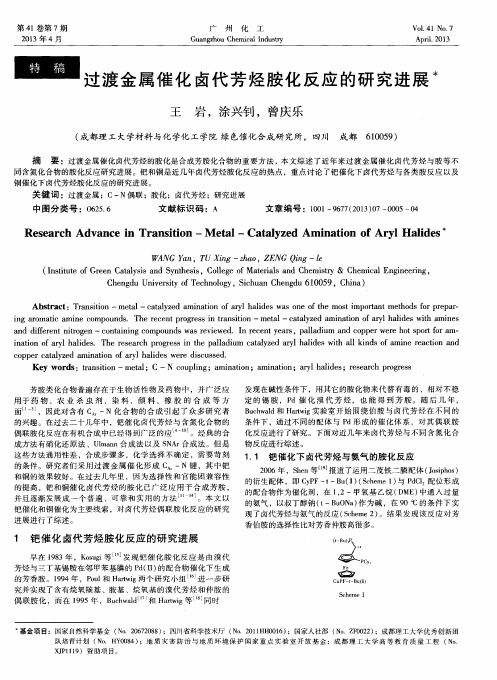
第4 1卷第 7期 2 0 1 3年 4月
广
州
化
工
V0 1 . 4l No . 7 Apr i l .2 01 3
Gua n g z ho u Che mi c a l I n d us t r y
过 渡 金 属 催 化 卤代 芳 烃 胺 化 反 应 的 研 究 进 展 水
芳胺类化合物普遍存在 于生 物活性物 及药物 中 ,并广泛应 用于 药 物 、农 业 杀 虫 剂 、染 料 、颜 料 、橡 胶 的 合 成 等 方 面 。 ,因此对含有 c 一N化合 物 的合 成引 起 了众多研 究 者
发现 在碱性条件下 ,用其它 的胺化物来 代替有 毒的 、相对不 稳 定 的 锡 胺 ,P d催 化 溴 代 芳 烃 ,也 能 得 到芳 胺。 随 后 几 年 , B u c h w a l d和 H a r t w i g实验室开始 围绕伯 胺与 卤代芳 烃在 不 同的 条件 下 ,通过不 同的配体 与 P d形 成 的催 化体 系 ,对其 偶联 胺 化反应进 行了研究 。下面对近几年来 卤代芳烃与不 同含氮化 合 物反应进行综述 。
还原胺化加料顺序
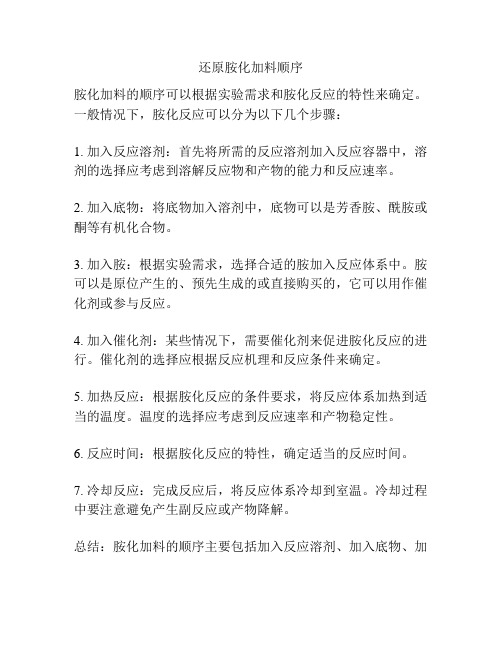
还原胺化加料顺序
胺化加料的顺序可以根据实验需求和胺化反应的特性来确定。
一般情况下,胺化反应可以分为以下几个步骤:
1. 加入反应溶剂:首先将所需的反应溶剂加入反应容器中,溶剂的选择应考虑到溶解反应物和产物的能力和反应速率。
2. 加入底物:将底物加入溶剂中,底物可以是芳香胺、酰胺或酮等有机化合物。
3. 加入胺:根据实验需求,选择合适的胺加入反应体系中。
胺可以是原位产生的、预先生成的或直接购买的,它可以用作催化剂或参与反应。
4. 加入催化剂:某些情况下,需要催化剂来促进胺化反应的进行。
催化剂的选择应根据反应机理和反应条件来确定。
5. 加热反应:根据胺化反应的条件要求,将反应体系加热到适当的温度。
温度的选择应考虑到反应速率和产物稳定性。
6. 反应时间:根据胺化反应的特性,确定适当的反应时间。
7. 冷却反应:完成反应后,将反应体系冷却到室温。
冷却过程中要注意避免产生副反应或产物降解。
总结:胺化加料的顺序主要包括加入反应溶剂、加入底物、加
入胺、加入催化剂、加热反应、反应时间和冷却反应。
具体的顺序可以根据实验需求和反应条件来确定。
还原胺化反应综述
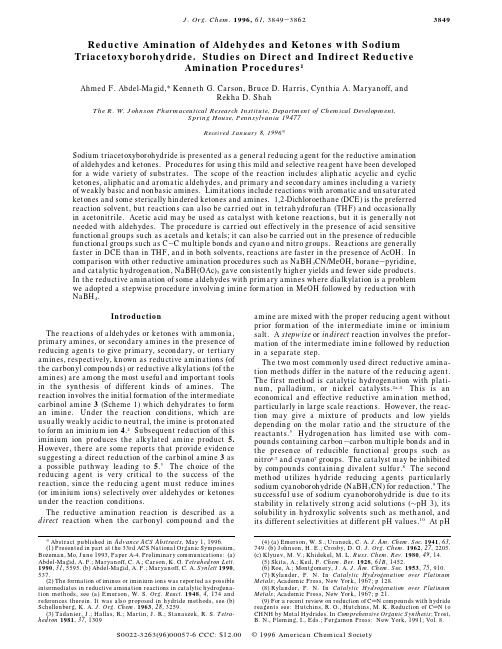
Reductive Amination of Aldehydes and Ketones with Sodium Triacetoxyborohydride.Studies on Direct and Indirect ReductiveAmination Procedures1Ahmed F.Abdel-Magid,*Kenneth G.Carson,Bruce D.Harris,Cynthia A.Maryanoff,andRekha D.ShahThe R.W.Johnson Pharmaceutical Research Institute,Department of Chemical Development,Spring House,Pennsylvania19477Received January8,1996XSodium triacetoxyborohydride is presented as a general reducing agent for the reductive amination of aldehydes and ketones.Procedures for using this mild and selective reagent have been developed for a wide variety of substrates.The scope of the reaction includes aliphatic acyclic and cyclic ketones,aliphatic and aromatic aldehydes,and primary and secondary amines including a variety of weakly basic and nonbasic amines.Limitations include reactions with aromatic and unsaturated ketones and some sterically hindered ketones and amines.1,2-Dichloroethane(DCE)is the preferred reaction solvent,but reactions can also be carried out in tetrahydrofuran(THF)and occasionally in acetonitrile.Acetic acid may be used as catalyst with ketone reactions,but it is generally not needed with aldehydes.The procedure is carried out effectively in the presence of acid sensitive functional groups such as acetals and ketals;it can also be carried out in the presence of reducible functional groups such as C-C multiple bonds and cyano and nitro groups.Reactions are generally faster in DCE than in THF,and in both solvents,reactions are faster in the presence of AcOH.In comparison with other reductive amination procedures such as NaBH3CN/MeOH,borane-pyridine, and catalytic hydrogenation,NaBH(OAc)3gave consistently higher yields and fewer side products. In the reductive amination of some aldehydes with primary amines where dialkylation is a problem we adopted a stepwise procedure involving imine formation in MeOH followed by reduction with NaBH4.IntroductionThe reactions of aldehydes or ketones with ammonia, primary amines,or secondary amines in the presence of reducing agents to give primary,secondary,or tertiary amines,respectively,known as reductive aminations(of the carbonyl compounds)or reductive alkylations(of the amines)are among the most useful and important tools in the synthesis of different kinds of amines.The reaction involves the initial formation of the intermediate carbinol amine3(Scheme1)which dehydrates to form an imine.Under the reaction conditions,which are usually weakly acidic to neutral,the imine is protonated to form an iminium ion4.2Subsequent reduction of this iminium ion produces the alkylated amine product5. However,there are some reports that provide evidence suggesting a direct reduction of the carbinol amine3as a possible pathway leading to5.3The choice of the reducing agent is very critical to the success of the reaction,since the reducing agent must reduce imines (or iminium ions)selectively over aldehydes or ketones under the reaction conditions.The reductive amination reaction is described as a direct reaction when the carbonyl compound and the amine are mixed with the proper reducing agent without prior formation of the intermediate imine or iminium salt.A stepwise or indirect reaction involves the prefor-mation of the intermediate imine followed by reduction in a separate step.The two most commonly used direct reductive amina-tion methods differ in the nature of the reducing agent. The first method is catalytic hydrogenation with plati-num,palladium,or nickel catalysts.2a,4This is an economical and effective reductive amination method, particularly in large scale reactions.However,the reac-tion may give a mixture of products and low yields depending on the molar ratio and the structure of the reactants.5Hydrogenation has limited use with com-pounds containing carbon-carbon multiple bonds and in the presence of reducible functional groups such as nitro6,7and cyano7groups.The catalyst may be inhibited by compounds containing divalent sulfur.8The second method utilizes hydride reducing agents particularly sodium cyanoborohydride(NaBH3CN)for reduction.9The successful use of sodium cyanoborohydride is due to its stability in relatively strong acid solutions(∼pH3),its solubility in hydroxylic solvents such as methanol,and its different selectivities at different pH values.10At pHX Abstract published in Advance ACS Abstracts,May1,1996.(1)Presented in part at the33rd ACS National Organic Symposium, Bozeman,Mo,June1993,Paper A-4.Preliminary communications:(a) Abdel-Magid,A.F.;Maryanoff,C.A.;Carson,K.G.Tetrahedron Lett. 1990,31,5595.(b)Abdel-Magid,A.F.;Maryanoff,C.A.Synlett1990, 537.(2)The formation of imines or iminium ions was reported as possible intermediates in reductive amination reactions in catalytic hydrogena-tion methods,see(a)Emerson,.React.1948,4,174and references therein.It was also proposed in hydride methods,see(b) Schellenberg,.Chem.1963,28,3259.(3)Tadanier,J.;Hallas,R.;Martin,J.R.;Stanaszek,R.S.Tetra-hedron1981,37,1309(4)(a)Emerson,W.S.;Uraneck,C.A.J.Am.Chem.Soc.1941,63, 749.(b)Johnson,H.E.;Crosby,.Chem.1962,27,2205.(c)Klyuev,M.V.;Khidekel,M.L.Russ.Chem.Rev.1980,49,14.(5)Skita,A.;Keil,F.Chem.Ber.1928,61B,1452.(6)Roe,A.;Montgomery,J.A.J.Am.Chem.Soc.1953,75,910.(7)Rylander,P.N.In Catalytic Hydrogenation over Platinum Metals;Academic Press,New York,1967;p128.(8)Rylander,P.N.In Catalytic Hydrogenation over Platinum Metals;Academic Press,New York,1967;p21.(9)For a recent review on reduction of C d N compounds with hydride reagents see:Hutchins,R.O.,Hutchins,M.K.Reduction of C d N to CHNH by Metal Hydrides.In Comprehensive Organic Synthesis;Trost, B.N.,Fleming,I.,Eds.;Pergamon Press:New York,1991;Vol.8.3849.Chem.1996,61,3849-3862S0022-3263(96)00057-6CCC:$12.00©1996American Chemical Society3-4it reduces aldehydes and ketones effectively,but this reduction becomes very slow at higher pH values.11At pH6-8,the more basic imines are protonated preferen-tially and reduced faster than aldehydes or ketones.10 This selectivity allows for a convenient direct reductive amination procedure.The literature is replete with publications that document the use of sodium cyanoboro-hydride in reductive amination reactions.12Limitations are that the reaction may require up to a fivefold excess of the amine,10is usually slow and sluggish with aromatic ketones10and with weakly basic amines,13and may result in the contamination of the product with cyanide.14The reagent is highly toxic15and produces toxic byproducts such as HCN and NaCN upon workup.Other reported reductive amination reagents include borane-pyridine,13a Ti(OiPr)4/NaBH3CN,13b borohydride exchange resin,16a Zn/AcOH,16b NaBH4/Mg(ClO4)2,16c and Zn(BH4)2/ZnCl2.16d In addition,there are some reports of electrochemical reductive amination reactions.17In our work on hydride-induced reductive aminations of aldehydes and ketones,we sought an alternative to the toxic sodium cyanoborohydride to eliminate the risk of residual cyanide in the product and in the workup waste stream,particularly for large scale reactions.Af-ter surveying many of the commercially available hy-dride reagents,we selected sodium triacetoxyborohydride [NaBH(OAc)3].18This borohydride reagent is mild and exhibits remarkable selectivity as a reducing agent.It reduces aldehydes selectively over ketones,18except for -hydroxy ketones which can be reduced selectively to give1,3-trans diols.19The steric and the electron-withdrawing effects of the three acetoxy groups stabilize the boron-hydrogen bond and are responsible for its mild reducing properties.20Our selection was also based on the results of reductive alkylation of amines using sodium borohydride in neat liquid carboxylic acids reported earlier by Gribble et al.21In this paper we report the results of our comprehen-sive investigation of the scope and limitations of sodium triacetoxyborohydride in a procedure for direct reductive amination of aldehydes and ketones with a variety of aliphatic and aromatic amines.This report also includes an alternative stepwise route for the reductive amination of aldehydes with primary amines which involves the preformation of imines and their subsequent reduction with NaBH4in one-pot reactions.Results and DiscussionsThe direct reductive amination reactions were carried out in1,2-dichloroethane(DCE),tetrahydrofuran(THF), or acetonitrile.The standard reaction conditions are as follows:a mixture of the carbonyl compound and the amine(0-5%molar excess)in the desired solvent is stirred with1.3-1.6equiv of sodium triacetoxyborohy-dride under a nitrogen atmosphere at room temperature. In some reactions,acetic acid(1-2mol equiv)is added to the mixture.The progress of the reaction is followed by GC and GC/MS analysis.The results from various reductive amination reactions of ketones and aldehydes are listed in Tables1and2,respectively.Solvents such as water or methanol are not recommended.Reactions in methanol resulted in a fast reduction of the carbonyl compound,and the reagent decomposed in water. (a)Reductive Amination of Ketones.The results in Table1show that the reductive amination of a wide variety of cyclic and acyclic ketones with primary and(10)Borch,R.F.;Bernstein,M.D.;Durst,H.D.J.Am.Chem.Soc. 1971,93,2897.(11)Borch,R.F.,Durst,H.D.J.Am.Chem.Soc.1969,91,3996.(12)(a)Hutchins,R.O.;Natale,.Prep.Proced.Int.1979, 11(5),201.(b)Lane,C.F.Synthesis1975,135.(13)Occasional use of weakly basic or nonbasic amines was reported, see for example:(a)Pelter,A.,Rosser,R.M.,Mills,S.J.Chem.Soc., Perkin Trans.11984,717.(b)Mattson,R.J.,Pham,K.M.;Leuck,D. J.;Cowen,.Chem.1990,55,2552.(c)Borch,R.F.;Hassid, .Chem.1972,37,1673.(d)Marchini,P.;Liso,G.;Reho,A.; Liberatore,F.;Moracci,.Chem.1975,40,3453.(14)(a)The product from large scale reduction of the imine(i)with sodium cyanoborohydride was contaminated with cyanide.(b)A similar result was reported recently:Moormann,mun.1993, 23,789.(15)For information on the safety data and health hazards associ-ated with sodium cyanoborohydride see:The Sigma-Aldrich Library of Chemical Safety Data,1st ed.;Lenga,R.E.,Ed.,Sigma-Aldrich Corp.:Milwaukee,1985,p1609.(16)(a)Yoon,N.M.;Kim,E.G.;Son,H.S.;Choi,mun. 1993,23,1595.(b)Micovic,I.V.;Ivanovic,M.D.;Piatak,D.M.;Bojic, V.Dj.Synthesis1991,1043.(c)Brussee,J.;van Benthem,R.A.T.M.; Kruse,C.G.;van der Gen,A.Tetrahedron:Asymmetry1990,1,163.(d)Bhattacharyya,S.;Chatterjee,A.;Duttachowdhhury,S.K.J.Chem. Soc.,Perkin Trans.11994,1.(17)(a)Pienemann,T.;Schafer,H.-J.Synthesis1987,1005.(b) Smirnov,Yu.D.;Tomilov,.Chem.U.S.S.R.1992,28(1), 42.(c)Smirnov,Yu.D.;Pavlichenko,V.F.;Tomilov,.Chem. U.S.S.R.1992,28(3),374.(18)(a)Gribble,G.W.;Ferguson, D. C.J.Chem.Soc.,Chem.Commun.1975,535.(b)Nutaitis,C.F.;Gribble,G.W.TetrahedronLett.1983,24,4287.(c)Gribble,G.W.In Encyclopedia of Reagentsfor Organic Synthesis;Paquette,L.A.,Ed.,John Wiley and Sons:NewYork,1995;Vol.7,p4649.(19)See for example:(a)Saksena,A.K.;Mangiaracina,P.Tetra-hedron Lett.1983,24,273.(b)Evans, D. A.;Chapman,K.T.Tetrahedron Lett.1986,27,5939.(c)Evans,D.A.,Chapman,K.T.;Carreira,E.M.J.Am.Chem.Soc.1988,110,3560.(20)Gribble,G.W.;Nutaitis,.Prep.Proced.Int.1985,17,317.(21)Earlier work by Gribble et al.demonstrated the potential oftriacyloxyborohydrides generated from NaBH4in neat liquid carboxylic acids in reductive alkylation of amines:(a)Gribble,G.W.;Lord,P.D.;Skotnicki,J.;Dietz,S.E.;Eaton,J.T.;Johnson,J.L.J.Am.Chem.Soc.1974,96,7812.(b)Gribble,G.W.;Jasinski,J.M.;Pellicone,J.T.;Panetta,J.A.Synthesis1978,766.Scheme1.Chem.,Vol.61,No.11,1996Abdel-Magid et al.secondary amines was successful under the standard conditions and gave the desired products in good to excellent yields.The scope of the reaction includes different alicyclic ketones,from cyclobutanone to cy-clododecanone(Table1:entries1-23),bicyclic ketones such as norcamphor and tropinone(Table1:entries24-30),saturated acyclic ketones(Table1:entries31-39), and keto esters(Table1:entries47-49).Nearly all primary and nonhindered secondary amines were used successfully in these reactions.For the same ketone,the rate of the reaction was dependent on the steric and electronic factors associated with the amines.In general, primary aliphatic amines reacted faster than primary aromatic and secondary aliphatic amines(Table1:en-tries10vs11;14and15vs16and17;24vs26and27). Cyclic secondary amines such as morpholine reacted faster than acyclic secondary amines such as diethyl-amine(Table1:entry33vs36)while the sterically hindered diisopropylamine did not react even after days (Table1:entry45).In some slow reactions(e.g.,Table 1:entries11,27,32,34,and36),small amounts of side products were formed(1-5%by GC area%analysis) from N-ethylation and N-acetylation of the starting amines.22These impurities were easily removed in the workup or during the recrystallization of the salts. The reaction conditions are very mild and can tolerate the presence of acid sensitive functional groups such as acetals and ketals.For example,the reductive amination of cyclohexanedione monoethylene ketal with primary and secondary amines afforded good to excellent isolated yields of the corresponding amines(Table1:entries14-18).Another example is the reductive alkylation of aminoacetaldehyde diethyl acetal with cyclododecanone (Table1:entry9).A particularly useful example is the reaction involving cyclohexanedione monoethylene ketal and aminoacetaldehyde diethyl acetal(Table1:entry18) which provides a secondary amine product containing protected aldehyde and ketone functionalities in a nearly quantitative yield.Of all the ketones used in this study,small aliphatic cyclic ketones,ranging from cyclobutanone to cyclohex-anone,were most rger cyclic ketones such as cyclooctanone and cyclododecanone and acyclic ketones such as2-heptanone reacted somewhat slower.Reactiv-ity of cyclobutanone was so high that its reaction with benzylamine gave a mixture of mono-and dicyclobutyl-benzylamines even with the use of excess amine(Table 1:entry2).Clean formation of N,N-dicyclobutylbenzyl-amine resulted with the use of a1:2molar ratio of amine to ketone(Table1:entry1).The reactions with second-ary amines were very effective since there was no dialkylation product(Table1:entry3).The least reactive ketones were aromatic,R, -unsatur-ated,and sterically hindered ketones.Aromatic and R, -unsaturated ketones reacted very slowly(Table1:entries 40,41,and43).Experimentally,a saturated aliphatic ketone was reductively aminated,selectively,and quan-titatively in the presence of an aromatic or R, -unsatur-ated ketone(Table1:entries42and44).The unreacted ketones were recovered unchanged except for the forma-tion of trace amounts of their imines(as determined by GC/MS analysis of the reaction mixture).Sterically hindered ketones were even less reactive than aromatic and R, -unsaturated ketones,e.g.,camphor showed no reaction with benzylamine after four days(Table1:entry 46).The steric factors associated with both ketones and amines seem to be very important in determining the outcome of the reaction.In reactions where the formation of diastereomers was possible,we observed varying degrees of selectivity. Reductive amination of4-tert-butylcyclohexanone with pyrrolidine and cyclohexylamine occurred with a moder-ate diastereoselectivity to give the thermodynamically less favored cis products.This results from equatorial attack by the hydride reagent on the intermediate imine, to form the axial amine(Table1:entries19and20).23 The reductive amination of androstanolone with isopro-pylamine gave a mixture of3R-and3 -(isopropylamino)-androstan-17 -ol in about25:75ratio(Table1:entry21). The reactions involving bicyclic ketones showed higher degrees of diastereoselectivity.For example,the reduc-tive aminations of norcamphor led to the exclusive formation of the endo products,from exo attack by the hydride reagent.The reductive amination of norcamphor with benzylamine(Table1:entry24)produced a single product.This product was identical to that obtained from the reductive amination of benzaldehyde with endo-2-aminonorbornane(Table2:entry13),thus confirming the endo stereochemistry of the product.Reductive amination of tropinone with primary amines such as benzylamine and aniline(Table1:entries28and 29)was accomplished in good yield and high diastereo-selectivity giving the endo isomer as the major product (determined by1H NMR).24The reaction with benzyl-amine gave the endo and exo products in approximately 20:1ratio while the reaction with aniline showed no detectable exo product.The reaction of tropinone with piperidine was extremely sluggish giving low conversion to about a1:1mixture of the exo-and endo-products after four days of reaction(Table1:entry30).The poor solubility of ammonium acetate in DCE,THF, or CH3CN limits its use in the reductive amination of ketones to prepare primary amines.The initial primary amine product is much more soluble than ammonium acetate and reacts faster with the ketone to generate dialkylamines,so this reaction can be used for the preparation of symmetrical dialkylamines.The amina-tion reaction is relatively slow and some ketone reduction may occur if AcOH is added.Even the use of a large excess(10equiv)of ammonium acetate in THF,DCE,or CH3CN,in the presence of Et3N,did not favor the formation of the monoalkylamine,the only product formed was dicycloheptylamine(Table1:entries22 and23).N-Substituted R-amino esters were prepared by the reductive amination of R-keto esters with primary and(22)The N-ethylation of amines is a major process in reaction of amines with sodium borohydride in neat acetic acid and is believed to proceed through an acetaldehyde formation.21a(23)This result is consistent with literature reports on the reduction of4-substituted cyclohexanone imines or iminium salts which con-cluded that bulky hydride reagents such as L-Selectride attack preferentially from the less hindered equatorial side to give the cis-products,while less bulky hydride reagents such as NaBH4and NaBH3-CN slightly favor the axial approach,see:(a)Wrobel,J.E.;Ganem, B.Tetrahedron Lett.1981,22,3447.(b)Hutchins,R.O.;Markowitz, .Chem.1981,46,3571.(c)Hutchins,R.O.;Su,W.-Y.; Sivakumar,R.;Cistone,F.;Stercho,.Chem.1983,48,3412.(d)Hutchins,R.O.;Adams,J.;Rutledge,.Chem.1995, 60,7396.(24)Chemical shift assignments of individual protons were arrived at by COSY,HETCOR,and Inverse HMBC NMR experiments.The stereochemistry of N-phenyl-3-aminotropane and N-benzyl-3-aminotro-pane was assigned based on1D NOE and coupling experiments.The assignments were in line with other literature reports;cf.Bagley,J. R.;Riley,T.N.J.Hetrocycl.Chem.1977,14,599and references therein.Reductive Amination of Aldehydes and Ketones .Chem.,Vol.61,No.11,19963851Table 1.Reductive Amination ofKetones.Chem.,Vol.61,No.11,1996Abdel-Magid et al.secondary amines.The reductive amination of methyl pyruvate with benzylamine was a fast and efficient reaction under the standard conditions that gave N -benzylalanine methyl ester in an excellent yield (Table 1:entry 47).The reaction was slower with hindered keto esters such as methyl 3-methyl-2-oxobutanoate (Table 1:entry 48),and the competing ketone reduction was a major reaction.The aromatic keto ester,methyl benzoyl formate reacted even slower with benzylamine and was also accompanied by considerable ketone reduction (Table 1:entry 49).Reactions involving other less reactive amines such as aniline or morpholine were much slowerTable 1.(Continued)Reductive Amination of Aldehydes and Ketones.Chem.,Vol.61,No.11,19963853and gave increasing amounts of ketone reductions. Whenever ketone reduction was a problem,the conditions were modified to use the amines as limiting reagents. The excess ketones were completely reduced to the corresponding alcohols which required the occasional addition of excess reducing agent.N-Substituted R-ami-no esters were also prepared by the reductive amination of R-amino esters with ketones,e.g.,N-(2-butyl)glycine ethyl ester was prepared in very good yield from ethyl glycinate and2-butanone(Table1:entry50).The reductive amination of cyclohexanedione mono-ethylene ketal with phenylhydrazine gave cleanly the N-substituted phenylhydrazine(Table1:entry51)in nearly quantitative yield.Other ketones such as cyclo-hexanone and2-heptanone reacted to give similar prod-ucts(Table1:entries52and53);however,there were some competing side reactions.The crude products showed the formation of byproducts,about15%with cyclohexanone and31%with2-heptanone.Attempted reductive amination of cyclooctanone with hydroxylamine was not successful and resulted in the oxime formation (Table1:entry54).Reductive aminations in which diamines containing both primary and secondary amino groups were studied and in general,primary amines reacted faster.In the case where the primary amino group was aliphatic and the secondary group was aromatic,e.g.,N-phenylethyl-enediamine,there was a clear difference in reactivity between the two amines.The reaction with4-heptanone gave a quantitative yield of the product resulting from exclusive reaction with the primary amine(Table1: entry55).In the case where both amino groups were aliphatic,such as1-(2-aminoethyl)piperazine,there was a high selectivity(94:6)for the primary group in reaction with acetylcyclohexane(Table1:entry56).(b)Reductive Amination of Aldehydes.Unlike ketones,aldehydes can be reduced with sodium triac-etoxyborohydride.18Thus,the possibility exists that the reduction of the aldehyde would compete with the reduc-tive amination process under the standard conditions. However,these conditions were so selective that the reductive aminations with aldehydes occurred very ef-fectively and resulted in fast reactions with no aldehyde reductions in most cases studied(Table2).One case in which aldehyde reduction was detected involved a reac-tion with the very sterically hindered diisopropylamine (Table2:entry6).All other examples in Table2resulted in fast and efficient reductive aminations with a variety of aliphatic primary and secondary amines as well as aniline with no detectable aldehyde reductions.Both aliphatic and aromatic aldehydes were very reactive and gave reductive amination products with a broad variety of primary and secondary amines.The reaction times ranged from20min to24h.The mildness of the reac-tion conditions is well illustrated in the reductive ami-nation of1,1′,2-tris-nor-squalene aldehyde with dieth-ylamine and diisopropylamine(Table2:entries19and 20).The aldehyde was cleanly converted to the corre-sponding amines in high yields with no detectable side reactions.In the reductive amination of aldehydes with primary amines,formation of dialkylated amines is a common side reaction.5This side reaction was rarely a problem in most reactions reported in Table2.In the few cases when it was detected,it was suppressed by the addition of up to5%molar excess of the primary amine.However, the dialkylation of amines remained a problem with certain substrates.25An alternative stepwise procedure for such systems is discussed later in this paper. Some aldehydes,such as formaldehyde and glutaral-dehyde are only available commercially as aqueous solutions which may restrict their use under the above reaction conditions because of the decomposition of the hydride reagent with water.However,the reaction may be carried out in DCE with excess hydride reagent,e.g., the reductive amination of either aqueous glutaraldehyde or formaldehyde with1-phenylpiperazine and about4 hydride equivalents was carried out on10mmol scale (Table2:entries21and22)and gave nearly quantitative yields of the corresponding amines.This,however,may not be suitable for large scale reactions.The use of phenylhydrazine in reductive amination of benzaldehyde was not successful,resulting only in hy-drazone formation.Generally,with either ketones or aldehydes,reactions in DCE were noticeably faster than those carried out in THF(e.g.,Table1:entries6vs7;25vs26and Table2: entries3vs4;9vs10).Also,in the same solvent, reactions were consistently faster in the presence of1 (or more)mol equiv of acetic acid.For most ketones, reactions were improved in the presence of acetic acid. However,the addition of acetic acid is not always advantageous to the reaction.Most reactions with al-dehydes are fast and do not require addition of AcOH. Addition of AcOH to a slow reaction,e.g.,cyclohexan-ecarboxaldehyde with diisopropylamine,resulted in a fast reaction accompanied with about25%aldehyde reduc-tion,and the yield of the isolated desired product was only41%.When the reaction was carried out in the absence of AcOH,the reaction was slower;however,the aldehyde reduction was only about5%,and the isolated yield of the purified reductive amination product in-creased to75%(Table2:entries6and7).Direct com-parisons were made between reactions in DCE and THF and with or without added acetic acid in representative reactions.The rate of product formation was determined quantitatively26in each case.The results of these com-parisons were in agreement with the above observations.(c)Reductive Amination with Weakly Basic and Nonbasic Amines.Few literature references have dealt with aromatic amines containing electron withdrawing substituents in reductive amination reactions.13,21a Cata-lytic hydrogenation conditions do not allow the presence of many of the easily reduced electron-withdrawing substituents such as cyano and nitro groups,since these substituents are often reduced under catalytic hydroge-nation conditions.6,7On the other hand,we and others13a,b have found the most used hydride reagent,sodium cyanoborohydride[NaBH3CN],to be sluggish and inef-ficient when used with these weak bases in reductive amination reactions.As a consequence of substitution by electron-withdraw-ing substituents,these amines are both poor nucleophiles and weak bases(e.g.,p K a3.98for4-chloroaniline,1.02 for4-nitroaniline,-0.29for2-nitroaniline,-4.26for2,4-dinitroaniline).27This slows the initial nucleophilic at-(25)For a discussion of the dialkylation side reactions involvingγ-andδ-amino esters with aldehydes and a mechanistic explanation, see:Abdel-Magid,A.F.;Harris,B.D.;Maryanoff,C.A.Synlett1994, 81.(26)The progress of these reactions was followed by GC.Linear standard curves of the response factors by GC areas of starting materials and expected products were determined to allow the quantitative measurements of their concentrations in the reaction mixtures..Chem.,Vol.61,No.11,1996Abdel-Magid et al.tack on the carbonyl carbon and leads to slower overall reaction rates (Scheme 2).In addition,the carbonyl group now competes effectively with the less basic intermediate imine for protonation and subsequently for the hydride in the reduction step.2b This may lead to a significant carbonyl reduction,consumption of both the carbonyl compound and the reducing agent and low yields of the reductive amination products.The reducing agent and reaction conditions should be chosen carefully to minimize such side reactions.Table 2.Reductive Amination ofAldehydesReductive Amination of Aldehydes and Ketones .Chem.,Vol.61,No.11,19963855Sodium triacetoxyborohydride is very efficient in re-ductive amination reactions with such unreactive amines. The results from several reactions are listed in Table3. In several cases such as monosubstituted anilines(e.g., p-nitro-p-carbethoxy-,and p-cyanoanilines),the standard reaction conditions described previously(about1:1ratio of carbonyl compound to amine,1.4equiv of NaBH(OAc)3 with1equiv of acetic acid)were adequate.However, with less basic amines such as o-nitroaniline,2,4-dichlo-roaniline,or2-aminothiazole,the reaction conditions were modified to compensate for the aforementioned effects and to maximize the yields of the reductive amination products.The optimum conditions included the use of the amine as the limiting reagent with1.5-2 mol equiv of the carbonyl compound,2-3equiv of NaBH-(OAc)3,and2-5equiv of AcOH in1,2-dichloroethane. Under these conditions,a variety of weakly basic amines were successfully employed in the reductive aminations of ketones and aldehydes in isolated yields ranging from 60%to96%.The reaction is convenient and the condi-tions are mild and show a high degree of tolerance for a variety of functional groups including nitro,cyano,halo, carboxy,and carbethoxy groups.Ketones reacted effectively with p-monosubstituted anilines to give good yields of the reductive amination products(Table3:entries1-8).The reaction was slightly slower with2,4-dichloroaniline and gave a high yield of the desired reductive amination product in addition to some ketone reduction and the formation of about3%of N-ethyl-2,4-dichloroaniline(Table3:entry 9).The reaction became very slow with o-nitroaniline which progressed only to about30%conversion to the reductive amination product and17%of N-ethyl-2-nitroaniline after6days(Table3:entry10).The reaction stopped completely when both ortho positions were substituted as in2,6-dibromo-and2,4,6-trichloro-anilines(Table3:entries11and12).The reactions with aldehydes were faster than those with ketones and gave higher yields from similar reac-tions.Aldehyde reductions occurred only with the least reactive amines.In the reductive amination of aldehydes with p-carboxyaniline and p-nitroaniline(Table3:en-tries13,14,and18),no competing aldehyde reduction was observed.In these cases,the standard conditions were used.With weaker amines such as2,4-dichloro-aniline and o-nitroaniline(Table3:entries15and16), the conditions were modified to use the amine as a limiting reagent since aldehyde reduction occurred to the extent of10-30%.This procedure was applied to other weakly basic primary amines such as2-aminothia-zole(Table3:entries22and23)and secondary amines such as iminostilbene(Table3:entry24).While imi-nostilbene reacted with hexanal to give a high yield of the N-hexyl product,the dihydro analogue iminodiben-zyl gave no reaction under the same conditions(Table3: entry25).One of the most unique reactions,however,was the reductive alkylation of p-toluenesulfonamide with ben-zaldehyde to give the N-benzyl derivative(Table3:entry 26).The reaction is carried out initially under the standard conditions in the presence of Et3N(2equiv). The aldehyde is usually consumed in about24h to give a mixture of N-benzyl p-toluenesulfonamide and N-benzal p-toluenesulfonamide.The reaction mixture is then treated with AcOH(2.5equiv)and additional NaBH(OAc)3(1equiv)to finish the reduction.The reaction,however,was not successful with ketones or carboxamides.The least reactive amines,2,4-dinitroaniline and2,4,6-trichloroaniline failed to undergo reductive amination with benzaldehyde(Table3:entries20and21).Cyclo-hexanecarboxaldehyde,on the other hand,reacted slowly with these two amines to give the corresponding reduc-tive amination products.In these two reactions,the aldehyde reduction became a major reaction process.To assure the presence of enough aldehyde to react with the amine,the reaction required occasional additions of aldehyde and reducing agent,up to5equiv each and over a two to four day period(Scheme3).The reactions progressed to reach90-92%conversion(as determined by GC)and gave61%and58%isolated yields,respec-tively,after chromatography.It is possible that these reactions proceed via initial formation of intermediate enamines rather than imines which may explain the lack of reactivity of aromatic aldehydes which cannot form enamines.(d)Comparison with Other Reducing Agents.In general,the results of reductive amination employing sodium triacetoxyborohydride were as good as or better than most comparable reported results whether done using hydrogenation or hydride reagents.However,in many cases,our results were far superior to others.For example,we compared the reductive amination of cyclo-hexanone with morpholine using NaBH3CN vs NaBH-(OAc)3.The reaction with NaBH3CN(6hydride equiv) in methanol and in the absence of AcOH was only34% complete after23h with the formation of about10%of the corresponding enamine.The conversion improved to 50%in23h with AcOH(1equiv)with no enamine formation.The reaction using the standard NaBH(OAc)3 conditions was99.8%complete in3h without a trace of enamine formation(Table1:entry5).In another comparison,the reductive amination of1-carbethoxy-4-piperidinone with p-chloroaniline was only45%complete with NaBH3CN after22h but was>96%with NaBH-(OAc)3in2.5h(Table3:entry4).An impressive result was obtained in the reductive amination of1,1′,2-tris-nor-squalene aldehyde with di-ethylamine and isopropylamine.These reactions were reported to give about5%yield under regular Borch conditions.28The yields were improved to46and42%, respectively,when the reactions were carried out with NaBH3CN in anhydrous THF in the presence of HCl(pH 3).29Under our standard conditions,these reactions gave(27)(a)Albert,A.;Serjeant,E.P.In The Determination of Ionization Constants;Chapman and Hall:London,1971;p91.(b)Yates,K;Wai, H.J.Am.Chem.Soc.1964,86,5408.(28)Duriatti,A.;Bouvier-Nave,P.;Benveniste,P.;Schuber,F.; Delprino,L.;Balliano,G.;Cattel,L.Biochem.Pharmacol.1985,34, 2765.(29)Ceruti,M.;Balliano,G.;Viola,F.;Cattel;L.;Gerst,N.;Schuber,F.Eur.J.Med.Chem.1987,22,199.Scheme2.Chem.,Vol.61,No.11,1996Abdel-Magid et al.。
氨解和胺化

环氧乙烷与20%~30%氨水进行加成胺化,生成 一乙醇胺、二乙醇胺和三乙醇胺的混合物,三 者比例与氨的用量有关。
5.2 乙二胺的制备
由环氧乙烷与过量的液氨在100℃、32.4MPa进 行加成胺化和羟基氨解而得。
6 脂肪族卤素衍生物的氨解 氨解只用于卤素衍生物价廉易得的情况
低碳卤烷易氨解,可用氨水作氨解剂;高碳卤烷活性 较低,要用氨的醇溶液或液氨作氨解剂。
• 氨水:工业氨水的浓度—般为25%,是广泛使 用的氨基化剂。参加氨基化反应的是NH3。它 的优点是操作方便,过量的氨可蒸出,用水吸 收,回收的氨水可循环使用,适用面广。缺点
• 是对某些芳香族被氨解物溶解度小,水的存在 有时会引起水解副反应。C8低碳脂肪胺的主要方 法。
采用Cu、Ni、Cu-Ni骨架型催化剂,在高 压釜中进行。
4 羰基化合物的胺化氢化 羰基化合物的胺化氢化主要用于从乙醇、
丙酮、甲乙酮等制备相应的脂肪胺。主 要用骨架镍或Ni/Al2O3等催化剂,可用气固相法或液相法。
5 环氧烷类的加成胺化
环氧烷类容易与氨或胺等亲核物质发生开环加 成胺化反应生成N-羟乙基化合物。
氨解和胺化
1 概述
• 氨基化包括氨解和胺化 • 氨解指的是氨与有机分子发生复分解反应,
生成伯胺。 • 胺化指的是氨与双键发生加成反应生成胺。
2 氨基化剂
• 氨基化剂主要是液氨和氨水,有时也用到氨气 和含氨基的化合物。
• 液氨:液氨用于需要避免水解副反应的氨基化 过程,缺点是:操作压力高,过量的液氨较难 再以液态氨的形式回收。
卤烷的活性次序是:
R-I>R-Br>R-Cl>R-F 为了减少仲胺和叔胺的生成,常用过量很多的氨水。
6.1 从二氯乙烷制乙烯多胺类 二氯乙烷容易与氨水反应,生成氯乙胺和乙二胺(乙 烯二胺),它们容易进一步与氯乙胺或二氯乙烷反应, 生成二乙烯三胺、三乙烯四胺等各种多乙烯胺。
第九章氨基化

即将醇、氨和氢的 气态混合物在 200℃左右、常压 或不太高的压力下 通过Cu-Ni催化剂 而完成的。其整个 反应过程包括:醇 的脱氢生成醛或酮、 醛或酮的加成胺化、 羟基胺的脱水和烯 亚胺的加氢生成胺 等步骤。
-H2O 脱水
CH3 CH NH
+H2 加氢
CH3CH2NH2
2019/1/22
8
•仲胺的生成
发烟硫酸 30-60℃,6h,
SO3H
SO3H NH2
稀释及水解 125℃,5h
吐氏酸 SO3H NH2
SO3H SO3H
>60%NaOH,常压 190℃,4h
NH2
SO3H
2019/1/22
OH
J酸
25
9.3 卤素的氨解 9.3.1卤代芳烃的氨解(芳环上卤基的氨解)
Cl
200~230℃,7MPa
胺化 胺化指的是氨与双键加成生成胺的反应。
O NH2 + C H OHH C N H
H2O
CH N
H 加氢
2019/1/22
NH CH2
2
二、反应的目的
制备脂肪族伯、仲、叔胺及季铵盐
ClCH2CH2Cl +
H2O NH3 ~2MPa
H2NCH2CH2NH2
(H5C2)3N+ CH2 Cl-
N(C2H5)3 + ClCH2
2019/1/22
15
OH + NH3
NH2 2 NH
NH2 + H2O
以苯酚气相催化氨解制苯胺为例:
+ H2O
2019/1/22
16
其他酚类的氨解: 1、甲苯胺的生产:
化学反应中的胺化反应与胺化机理解析

化学反应中的胺化反应与胺化机理解析化学反应中的胺化反应是一种重要的有机合成反应,常用于合成含有胺基的化合物。
胺化反应的机理解析对于理解胺化反应的过程和优化反应条件具有重要意义。
胺化反应是指将含有氮原子的化合物与含有氢原子的化合物进行反应,生成胺类化合物的过程。
在胺化反应中,氮原子的孤对电子与氢原子形成成键,从而形成新的胺键。
胺化反应在有机合成中应用广泛,可以用于合成胺类化合物、氨基酸、多肽等。
胺化反应的机理可以从两个方面来解析:胺化反应的前体生成和胺化反应的进行过程。
首先,胺化反应的前体生成是胺化反应的关键步骤。
通常情况下,胺化反应的前体是由胺类起始物和氢原子供体经过一个中间体生成的。
以亚甲胺化反应为例,亚甲胺和甲醇反应生成甲醇胺和甲醛,甲醛再与另一个分子的亚甲胺反应生成亚甲胺醇。
这个亚甲胺醇就是胺化反应的前体,它能与其他化合物进行反应生成胺类化合物。
因此,胺化反应的前体生成是胺化反应的关键步骤之一。
其次,胺化反应的进行过程可以从分子层面进行解析。
在胺化反应中,胺化反应的前体与其他化合物发生反应,生成胺类化合物。
反应机理根据不同的胺化反应类型有所区别,但一般都遵循亲核加成机理。
以亚甲胺化反应为例,亚甲胺醇与芳香醛反应,亚甲胺醇的氮原子的孤对电子攻击芳香醛的电子不饱和部分,形成亚甲胺加成产物。
这个亚甲胺加成产物经过一系列的质子转移和质子解离的步骤,最终生成胺类化合物。
胺化反应的进行过程可以通过实验证明,例如核磁共振波谱、红外光谱等。
胺化反应在不同的实验条件下可能会有不同的机理路径,例如温度、催化剂、溶剂等因素的变化会影响胺化反应的过程和产物选择。
因此,胺化反应的机理解析对于优化胺化反应的条件和产物选择具有重要意义。
综上所述,化学反应中的胺化反应是一种重要的有机合成反应,胺化反应的机理解析可以帮助我们理解反应的过程和优化反应条件。
胺化反应的机理通过分析胺化反应的前体生成和反应进行过程可以得到。
胺化反应的机理解析对于有机化学领域的研究和应用具有重要的意义。
还原胺化反应的应用及其机理研究

还原胺化反应的应用及其机理研究胺化反应的应用及其机理研究
作为一种十分重要的化学反应,胺化反应在化学工业中有广泛应用,如用来制
备有机延迟剂、合成着色剂。
本文将对胺化反应的应用和机理进行深入研究,为此有效应用以及进一步的研究提供参考。
1. 胺化反应的应用
胺化反应是一种化学反应,主要是在胺基与有机物中的碳原子或其他碳基之间
新生成胺基。
其中,植物提取物中常见的胺化反应:氨基酸到酒精或醛类衍生物之间的反应,也主要用于制备有机延迟剂,如氨基氯元素。
此外,还可用于合成着
色剂,例如由氨基酸和酚类衍生物经胺化反应合成的着色剂,可以更好地改善食品的感官质量,使食物更加色彩缤纷。
2. 胺化反应的机理
胺化反应的机理主要是由胺基和有机物的碳原子的相互作用,从而形成一个芳
香族键,并且将胺基与有机物中的烃类或其他衍生物之间形成叉型分子结构。
在此反应中,活性H应用于驱动反应,成为衍生物生成胺基而非原子的活力试剂。
值得注意的是,胺基有其独立的酸性或碱性,往往会影响其与有机物之间的反应机理。
3. 结论
总的来说,准确的应用和掌握胺化反应的机理,将有助于更好地运用胺化反应,以满足相关新的应用需求。
此外,对胺化反应的机理的深入研究也有助于我们正确理解胺化反应所发生的物理化学过程,从而使我们更好地掌握胺化反应。
钯催化胺化偶联反应(四):反应机理

钯催化胺化偶联反应(四):反应机理
2016-08-14 13:20来源:内江洛伯尔材料科技有限公司作者:研发部
钯催化芳胺化反应机理解析
用于芳胺化反应的催化体系随着芳胺化反应机理的发展而逐渐发展。
因此芳胺化反应的机理研究有利于催化体系的改进。
Pd催化芳胺化反应的机理表明芳胺化反应包含3个历程: (1)卤代芳烃与钯化合物氧化加成; (2)胺与加成产物配位; (3)用碱去质子和还原消除产生芳胺。
最近几个机理研究都集中于催化循环中间物的性质及不同配体的影响。
Hartwig认为用DPPF为配体时,卤芳烃的氧化加成产物能与碱反应,生成Pd-醇化物,这个化合物与胺反应生成胺基芳烃钯化合物, 然后还原消除。
Amator对于ArI等量加成到(dba)Pd(BINAP)的详细动力学研究表明,消去dba的Pd比没有消去的更快。
Singh用原位实验研究监控Pd/BINAP催化溴苯与伯胺和仲胺偶联的整个过程:在过量胺存在时,动力学模型说明在卤芳烃氧化加成前,胺与Pd直接配位;卤芳烃氧化加成到(R(R′)NH)Pd(BINAP)比氧化加成到Pd(BINAP)更快。
胺的化性及制备

胺的化性及制备胺的化学性质及制备Ⅰ、胺的化学性质C N H(R)N H(R)主要化性:1、胺的N 有孤对电⼦,具有⼀定的碱性;2、胺具碱性,亦具亲核性,可与卤代烃、酰化剂发⽣烃基化、酰基化反应(叔胺不可);3、各级胺可与HNO 2发⽣特殊反应;4、芳胺中存在共轭,N 的给电⼦作⽤使芳胺的碱性↓,⽽苯环上的亲电取代反应活性↑;5、芳胺易氧化。
⼀、碱性NH 3 +HOH[NH 4]+ + OH -..RNH 2 +HCl3]+ Cl -..1、注:(1)胺是弱碱,不能使酚酞显⾊;芳胺由于N 上孤对电⼦参与了共轭,碱性更弱;(2)成盐可改善其⽔溶性,也可⽤于提纯胺。
例如:+NH 2COOCH 2CH 2N(C 2H 5)2HClNH 2COOCH 2CH 2N(C 2H5)2H Cl普鲁卡因盐酸普鲁卡因(局⿇剂)例如:⼄酰苯胺中常混有未反应完的苯胺,如何提纯?解:⼄酰苯胺HCl苯胺不溶溶解分离固体洗涤、⼲燥2、碱性影响因素(1)电⼦效应:N 上ρe ↑,碱性↑;(2)空间效应:N 周围位阻↑,碱性↓;(3)溶剂化效应:N +的溶剂化程度↑,碱性↑。
溶剂化效应:溶剂分⼦与离⼦相互作⽤⽽累积在离⼦周围,提⾼了离⼦的稳定性。
氨的盐通过氢键可与四个⽔分⼦溶剂化,伯胺盐可与三个⽔分⼦溶剂化,仲胺盐可与两个⽔分⼦溶剂化,叔胺盐可与⼀个⽔分⼦溶剂化,因此,在⽔溶液中,溶剂化程度顺序是:NH 3>伯胺>仲胺>叔胺+R 2NH H ............O HHOHH+R 3NH ......OH H(4)综合上述因素,在⽔溶液中,胺的碱性⼤⼩顺序为:季铵碱>脂肪胺>氨>芳胺①脂肪胺碱性与R 数⽬⽆正⽐关系,⼀般的:脂环仲胺>脂肪仲胺>脂肪伯胺、叔胺(掌握:⼆甲胺>甲胺>三甲胺)②芳胺碱性规律:芳伯胺>芳仲胺>芳叔胺;取代芳胺碱性与取代基性质有关。
- 1、下载文档前请自行甄别文档内容的完整性,平台不提供额外的编辑、内容补充、找答案等附加服务。
- 2、"仅部分预览"的文档,不可在线预览部分如存在完整性等问题,可反馈申请退款(可完整预览的文档不适用该条件!)。
- 3、如文档侵犯您的权益,请联系客服反馈,我们会尽快为您处理(人工客服工作时间:9:00-18:30)。
三芳胺化合物 Base: KOH
Ullmann condensation of diarylamines with iodobenzenes has been investigated under homogeneous and heterogeneous catalytic conditions with cuprous and curpic salts, as well as powdered copper metal. Copper catalyzed condensation of diarylamines with iodoaromatics is relatively insensitive to substituent (for substituted
芳胺化反应
报告人:张 俊 祥
Scheme
R'
+ NH2 R
Y Met.Cat., Base
Solvent
R
N
R'
R1
+ R2
N
R
Met.Cat., Base R1 Y
Solvent
R2 N
R
二芳胺化合物
Diarylamines were prepared by the condensation of an aniline with an
arenesulfonic acid
(8.90 mol)
(1.56 mol)
Condt.: NaNH2 (5.36 mol), KCl (5.36 mol), n-decane, heated to 195 C and stirred for 4 h,
Workup: The mixture was filtered and excess aniline removed under reduced pressure. Reduced pressure distillation yielded an orange–yellow oil. Recrystallisation from hexane gave the title compound (74%)
三芳胺化合物 Base: KOH
0.16 mole
+I
N
KOH, Cu
I
N
N
Soltrol.RTM . 170
0.08 mole
0.02 mole
Cat.: copper 6 g
Sol.: 12 ML Soltrol.RTM. 170
(a mixture of C13 –C15 aliphatic hydrocarbons from Phillips Chemical Com.). Condt.: 160.degree. C. about 5 hours.
iodobenzenes p = -0.25; for substituted diphenylamines p = 1.09) but quite sensitive to halogen ( k I / k B , > 200).
This hypothesis rationalizes many of the perplexing results which typify the literature associated with copper catalyzed nucleophilic aromatic substitution.
I
37 mmol 8 ml
N
+3
N
KOH, Cu, n-Decane
1.23 g
I
I 12 mmol
N
2.06 mmol
Condt.: Refluxed 48 h or until only one product spot could be detected by TLC.
Workup: Cooled and addition of methanol (50 cm3) which precipitated the crude product. filtered off, dissolved in CH2Cl2 and filtered. Purified by flash chromatograph. PE–dichloromethane eluted the title compound (65%).
Workup: Column chromatographed with toluene as eluent and recrystallized from n-octane to yield colorless crystals, Y:85%.
US 4,764,625 Xerox Cop.
三芳胺化合物 Base: KOH
J. Chem. Soc., Perkin Trans. 1, 2000, 2695–2701
二芳胺化合物 Base: K2CO3
10 mmol Cat.: CuI (0.25 mmol) Sol.: ethoxyethyl ether (25 mL) Condt.: 1,3-dibromobenzene (10 mmol), K2CO3 (10 mmol), reflux for 24 h Workup: filtered, filtrate thoroughly washed with EtOAc. Vacuum distillation, and the crude product was purified by chromatography ,recrystallization from hexane/EtOAc, providing Y: 51% J. Am. Chem. Soc. 1996, 118, 10626-10628
J. Am. Chem. SOC. 1987, 109, 1496-1502
三芳胺化合物 Base: K2CO3
1 mole
NH2 +
K2CO3 I
N
0.84 mol
1.79 mol
Cat.: copper 4.5 g
Sol.: 150 ml PhNO2 Condt.: refluxed together for 22 hours
